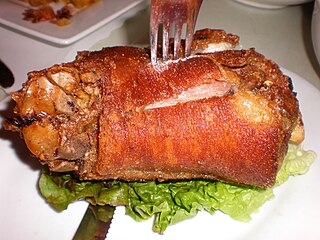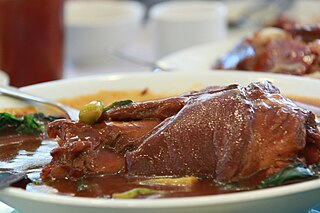
A pig's trotter, also known as a pettitoe, [1] is the culinary term for the foot of a pig. The cuts are used in various dishes around the world, and experienced a resurgence in the late 2000s. [2]

A pig's trotter, also known as a pettitoe, [1] is the culinary term for the foot of a pig. The cuts are used in various dishes around the world, and experienced a resurgence in the late 2000s. [2]


Before sale, the trotters are cleaned and typically have the hairs pulled with a hot tank and beaters. [3] They are often used in cooking to make stocks, as they add thickness to gravy, although they are also served as a normal cut of meat. [3] In Puerto Rico, a tomato-based stew of pig's trotters with chickpeas is called Patitas de Cerdo. Sometimes potatoes or butternut are added. Chef Marco Pierre White has long served trotters at his restaurants, [4] based on the original recipe of mentor Pierre Koffmann. [5] In the New York City restaurant Hakata Tonton, 33 of the 39 dishes served contain pig's trotters. [6]
Following the late-2000s financial crisis, there has been a boom in popularity of pig's trotters in the United Kingdom as a revival in cheap meat recipes occurred. [2] In 2008, British supermarket Waitrose reintroduced trotters to its stores, [4] and found that they quickly became popular. [2] In 2009, Pierre Koffmann set up a pop-up restaurant, and found that diners ate an entire month's stock of 500 pig's trotters in less than a week. [2]
In Norwegian tradition pigs feet are salted and boiled and served as syltelabb . This is a pre Christmas dish because the pig was slaughtered before Christmas, and everything was used. Today syltelabb is for enthusiasts. [7]


Head cheese or brawn is a cold cut terrine or meat jelly, often made with flesh from the head of a calf or pig, typically set in aspic, that originated in Europe. Usually eaten cold or at room temperature, the dish is, despite the name, not a dairy cheese. The parts of the head used in the dish vary, though commonly do not include the brain, eyes and ears of the animal used. The tongue, and sometimes the feet and heart of the animal may be included; the dish is also made using the trimmings from more commonly eaten cuts of pork and veal, with the addition of gelatin to the stock in order to act as a binding agent. Head cheese may also be made without utilising the flesh from the head of an animal.

Offal, also called variety meats, pluck or organ meats, is the organs of a butchered animal. The word does not refer to a particular list of edible organs, which varies by culture and region, but usually excludes muscle. Offal may also refer to the by-products of milled grains, such as corn or wheat.

Feijoada is a stew of beans with beef and pork. It is commonly prepared in Portugal, Brazil, Angola, Cape Verde, Guinea-Bissau, Mozambique, Timor, Goa, and Macau, where it is also considered a national dish. However, the recipe differs slightly from one country to another.

Aspic is a savoury gelatin dish made with a meat stock or consommé, set in a mold to encase other ingredients. These often include pieces of meat, seafood or eggs. Aspic is also sometimes referred to as aspic gelée or aspic jelly.

A ham hock or pork knuckle is the joint between the tibia/fibula and the metatarsals of the foot of a pig, where the foot was attached to the hog's leg. It is the portion of the leg that is neither part of the ham proper nor the ankle or foot (trotter), but rather the extreme shank end of the leg bone.
Romanian cuisine is a diverse blend of different dishes from several traditions with which it has come into contact, but it also maintains its own character. It has been mainly influenced by Turkish and a series of European cuisines in particular from the Balkans, or Hungarian cuisine as well as culinary elements stemming from the cuisines of the Slavic-speaking countries of Eastern and Central Europe.

Chicharrón is a dish generally consisting of fried pork belly or fried pork rinds. Chicharrón may also be made from chicken, mutton or beef.

Sisig is a Filipino dish made from parts of pig head and chicken liver, usually seasoned with calamansi, onions and chili peppers. It originates from the region of Pampanga in the island of Luzon.

Pig's ear, as food for human consumption, is the cooked ear of pig. It is found in a number of cuisines around the world.
Pierre Koffmann is a French professional chef. He was one of a handful of chefs in the United Kingdom to have been awarded the coveted three Michelin stars at his restaurant La Tante Claire in London. Until December 2016 he was the head chef of Koffmann's at The Berkeley hotel in Knightsbridge, London.

Crispy pata is a Filipino dish consisting of deep fried pig trotters or knuckles served with a soy-vinegar dip. It can be served as party fare or an everyday dish. Many restaurants serve boneless pata as a specialty. The dish is quite similar to the German Schweinshaxe.
La Tante Claire was a restaurant in Chelsea, London, which opened in 1977 and closed in 2004. Owned and operated by Pierre Koffmann, it gained three Michelin stars in 1983, and held all three until the restaurant moved premises in 1998. It was sold to Gordon Ramsay for his flagship restaurant, Restaurant Gordon Ramsay.

Olivier salad is a traditional salad dish in Russian cuisine, which is also popular in other post-Soviet countries, many European countries, Turkey, Iran, Mongolia and also throughout Latin America. In different modern recipes, it is usually made with diced boiled potatoes, carrots, brined dill pickles, green peas, eggs, celeriac, onions, diced boiled chicken or bologna sausage, and tart apples, with salt, pepper, and mustard added to enhance flavor, dressed with mayonnaise. In many countries, the dish is commonly referred to as Russian salad. A variation called Stolichny salad exists, and is also popular in the Russian cuisine.

Breaded cutlet is a dish made from coating a cutlet of meat with breading or batter and either frying or baking it. Breaded cutlet is known as schnitzel in German-speaking countries, cotoletta alla milanese in Italy, escalope in France, filete empanado in Spain, filete empanizado in Cuba, milanesa in Latin America, katsu in Japan and Korea, kotlet in Poland, and kotleta in post-Soviet countries.

Cuerito is pig skin from Mexican cuisine, Venezuelan cuisine and Spanish cuisine. Cuero is the Spanish-language word for leather or hide, so cueritos means "little leathers". They are usually pickled in vinegar and can be made with a spicy sauce. The vinegar can be seasoned with pineapple, dulce macho (piloncillo), cloves, peppercorns, chile de árbol and oregano. There are also family recipes.

Paksiw is a Filipino style of cooking, whose name means "to cook and simmer in vinegar." Common dishes bearing the term, however, can vary substantially depending on what is being cooked.

Babi kecap is an Indonesian braised pork with sweet soy sauce. It is a Chinese Indonesian classic, due to its simplicity and popularity among Chinese Indonesian households. It is also popular among non-Muslim Indonesians, such as the Balinese, Batak and Minahasan, and in the Netherlands, where it is known as babi ketjap, owing to colonial ties with Indonesia. In the Netherlands, the dish might also be served within an opulent rijsttafel banquet.

Pata tim, also spelled patatim, is a Filipino braised pork hock dish slow-cooked until very tender in soy sauce, black peppercorns, garlic, bay leaves, and star anise sweetened with muscovado sugar. It also commonly includes péchay and mushrooms. The dish is commonly served in regions in the Philippines with large Chinese Filipino populations, especially in the Binondo district of Manila.
| Wikimedia Commons has media related to Pork feet . |
| Wikibooks Cookbook has a recipe/module on |